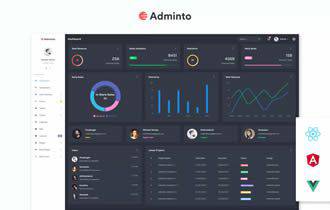There are a ton of content management system (CMS) options out there. And if you’re looking to find the perfect fit your website project, the search can be exhausting. Particularly if you don’t have a lot of experience with these systems.
But before you even choose a specific app, there’s another factor that needs to be considered. One that will have a major impact on your project in both the immediate and long term. Is the CMS you’re considering open-source or proprietary?
All too often, neither web designers nor website owners are fully aware of the differences. It’s only after they run into a roadblock that they realize the consequences of their choice. By then, it could be too late and too expensive to switch.
Today, we’ll fill you in on the differences between these two types of systems. The goal is to help you get the information you need to make the right choice from the very start.

2,000+ Templates

270+ Templates

150+ Templates

1,200+ Themes

550+ Plugins

8,200+ Templates
Definitions
Before we get too far into the weeds, let’s attempt to define what open-source and proprietary software are.
It may sound complex, but what we’re really talking about is how a piece of software is licensed. This is important because licensing determines what you can and can’t do with a particular app. Also, there could be an impact when it comes to things like content ownership, web hosting, and the ability to add additional functionality.
With that, here’s a quick (non-exhaustive) guide to each license type:
Open-Source
An open-source license grants its users access to the underlying source code of an application. This means you can typically change or extend its code to suit your needs and even redistribute it if you want. There may be rules that require you to credit the original developers, but you can feel free to add your own flavor wherever you like.
WordPress is perhaps the best-known example of an open-source CMS. You are free to hack away at the source code, create themes/plugins or even fork the software (as ClassicPress did).
One thing to note is that open-source doesn’t always mean the software is free. Think of buying a commercial WordPress theme, for example. You purchase the theme and then have the ability to customize its code. Whether that’s the right path for your project is another subject – but the option is there.

Proprietary
On the other hand, proprietary software enables the vendor (owner) to exercise exclusive rights. In practice, this means that the app’s owner can restrict its usage however they see fit. A user likely couldn’t, for example, directly modify the source code. However, they may still be able to create add-ons that enhance the software. User rights can vary greatly depending upon the particular vendor.
There is any number of other terms a user might have to agree to. With regards to a CMS, that could mean agreeing to host your website only with a particular provider or utilizing plugins from a vendor-approved marketplace.
Notable examples of proprietary CMS include Squarespace and Wix.

Pros, Cons, and Considerations for CMS Licensing
Both open-source and proprietary CMS applications have their strengths and weaknesses. Thus, some projects are a better fit for one licensing structure over the other. Then there are also plenty of differences within specific apps in each category.
But generally speaking, some major factors are endemic to the licensing structure itself. Let’s look at some areas where open-source and proprietary apps typically differ the most:
Data Portability
The ability to move your data from one CMS to another – or even one web host to another – is a pretty big deal. A license that doesn’t allow you to do this can be problematic for some. What happens if you no longer want to use that system?
This is where you need to read the licensing agreement carefully. A vendor is under no obligation to help you export your site’s design, content, and media files. Proprietary software may even disallow some or all of this completely.
Open-source software will likely offer a way to export at least some of this data. Even if it’s not built directly into the CMS, a third-party tool might also be utilized for this purpose.
If you want to move to a different system, don’t expect much leeway when it comes to design. Since themes are often tied to a particular CMS, moving between systems is not a straightforward process – regardless of licensing.

Web Hosting
Many proprietary CMS applications are based on a software-as-a-service (SaaS) model. That means the software is only licensed to run on a single web host. If you want to use the CMS, you’ll have to do so within that centralized hosting environment.
Along with the aforementioned data portability, open-source systems can usually be hosted just about anywhere. There may be some minimum server requirements (MySQL, a specific version of PHP, etc.) but your site’s files can be moved again and again.
Maintenance Updates
Every actively developed CMS will require some form of maintenance. Bugs need to be fixed and security tightened. And there is always room for new features and UI enhancements.
Licensing can often tell you a bit about how system maintenance works.
With open-source software, website owners are generally responsible for applying updates – although strides have been made in automation. Typically, you have the choice to decide when or whether to upgrade (or automate). Some managed web hosts also provide this service.
Proprietary systems often differ in that they may not offer you a choice in the matter. Some updates may be applied in the background. In other cases, a vendor might allow you to defer an update for a specified period of time.

Customization
The final area we’ll look at is the ability to customize a website’s look and functionality. The CMS licensing structure often impacts what you can and can’t do here as well.
Proprietary systems can run the gamut. Some will allow the use of custom themes and/or plugins, while others are much more closed off. Also, the availability of an official or third-party marketplace could mean more opportunities to tweak a website to meet your needs. But this all depends on the vendor.
Meanwhile, open-source systems generally allow for complete customization. You can build your own themes or plugins. You can also source these items from third parties. The back end of the software is also fair game for tweaking. There are no hard limits as to what’s allowed.
Finding the CMS That Works for You
Here’s hoping that you found the above considerations to be helpful and objective. We understand that each camp has its devoted fans – and for good reason. The decision of whether to go with an open-source or proprietary CMS can be deeply personal and depends on the past experiences we’ve had.
However, if you’re not committed to one licensing structure over the other, picking a side can be difficult. How can you be sure you’re making the right choice?
While we can’t decide for you, we can offer some advice. Think about your website project as a whole. Consider how you want to build, maintain and customize it. How much freedom and responsibility do you need or even want?
If you’re looking for low maintenance requirements and aren’t deterred by restrictive licensing, a proprietary CMS may be a perfect fit. Open-source, on the other hand, is a wonderful choice for those who want more control over every aspect of their site.
Once you’ve defined what you’re looking for, you can figure out which type of system works best for you. Good luck!
The post Proprietary vs. Open-Source: How to Choose the Right CMS appeared first on Speckyboy Design Magazine.